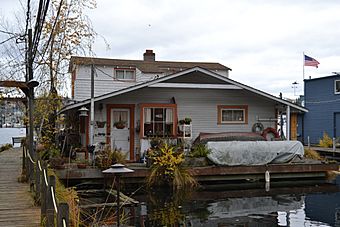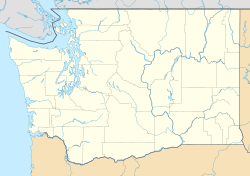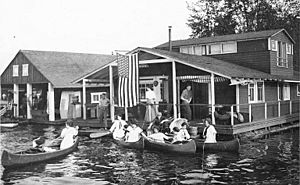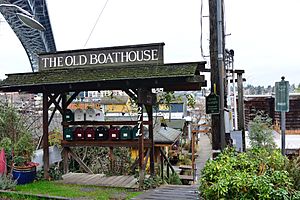Wagner Houseboat facts for kids
Quick facts for kids |
|
|
Wagner Houseboat
|
|

The Wagner Houseboat (2011)
|
|
| Location | 2770 Westlake Avenue, N. Seattle, Washington, U.S. |
|---|---|
| Nearest city | Seattle, Washington |
| Built | 1912 |
| Architectural style | Cottage style |
| NRHP reference No. | 82004255 |
| Added to NRHP | February 19, 1982 |
The Wagner Houseboat, also known as The Old Boathouse, is a special floating home in Seattle, Washington, United States. It floats on Lake Union near the Aurora Bridge. This historic boat was built way back in 1912. It's named after Richard Wagner, who bought it in the 1950s.
Richard and his wife Colleen later started the Center for Wooden Boats right from their houseboat! Today, the Wagner Houseboat shows how the South Lake Union area changed from a busy industrial place to a neighborhood where people live. It's also one of the few remaining houseboats from the old floating communities that used to be popular on Lake Washington. Because it's one of Seattle's oldest houseboats, the Wagner Houseboat was added to the National Register of Historic Places on February 19, 1982.
Contents
History of Houseboats
Building houseboats and other floating homes became popular in the Pacific Northwest in the late 1800s. At first, they were cheap places for workers in the lumber and fishing industries to live. Over time, houseboats started to get a bad reputation because of some illegal activities that happened near the water.
But then, things changed! When streetcars and cable cars were built to reach the Lake Washington waterfront, houseboats became popular with wealthier people. They used them for fun social gatherings. At one point, there were about 4,000 houseboats in and around Seattle! However, by the 1950s, that number dropped to around 500.
The Wagner Houseboat was built in 1912. It was first docked near Madison Park on Lake Washington. In 1938, the city of Seattle made a rule that houseboats on Lake Washington had to connect to sewer lines. This was expensive! So, many houseboats, including the Wagner Houseboat, moved from Lake Washington to Lake Union. Lake Union didn't have the same sewer rule until 1967. That's how the Wagner Houseboat ended up in its current spot.
The Wagners and Their Vision
In the late 1950s, Dick Wagner fell in love with Seattle during a summer internship. He was an architecture student in New York City and loved building design. Dick preferred learning by doing things with his hands. After finishing college, Dick came back to Seattle. He had a big dream to make Seattle a famous place for visitors.
Dick had a passion for teaching people how to sail, no matter how much money they had or where they came from. This led him to create the Center for Wooden Boats. His goal was to make sailing open to everyone and teach them through hands-on experience. Dick passed away in 2017.
Colleen Wagner also believed in hands-on learning. She was a talented artist and, with her husband, helped start the Center for Wooden Boats. Colleen loved maritime history, which is the history of boats and the sea. She also started the Discovery Modelers Education Center. Colleen was honored for her work in preserving maritime history. After Dick passed away, Colleen continued to live in the Old Boathouse until she passed away in 2020. People remember Colleen for her kind spirit and her love for maritime history.
The Center for Wooden Boats
The Wagner Houseboat is where the famous Center for Wooden Boats began! In the late 1950s, Dick and Colleen Wagner started collecting and fixing up old wooden boats. They kept their growing collection behind their home.
Using these boats, the couple decided to open a non-profit boat rental center. They hung a sign that said "The Old Boathouse" on the dock in front of their houseboat. The Old Boathouse officially opened as a non-profit on February 1, 1968. This was the start of the Center for Wooden Boats museum.
Soon, friends of the Wagners started coming to their home to help fix up the old wooden boats. This group of friends grew bigger and bigger. They were all very dedicated to saving the history of wooden boats. They would even stay late into the night helping Dick and Colleen.
The Wagners realized that this amazing group of volunteers could support a bigger non-profit organization. So, on February 3, 1976, Dick and Colleen started planning to officially open the Center for Wooden Boats. Their mission was to keep the history of sailing and wooden boats alive. They also wanted to make sure everyone, no matter their physical or financial situation, could get out on the water and learn to sail. When the Center for Wooden Boats officially opened, its operations moved out of the Wagner Houseboat to its own special location.
The Center for Wooden Boats (CWB) has built such a strong volunteer community that other non-profit leaders around the country have studied their success. Today, about 75,000 people visit CWB every year to enjoy the many water activities they offer.
Houseboat Design
The Wagner Houseboat was built as a summer home on Lake Washington. It was designed in the "Cottage Style," which means it looks like a cozy little house. It was built using wood from the local area. Its design shows how early houseboats were built.
One cool thing about the Wagner Houseboat's design is that it can be moved! If something unexpected happens, like a flood, the home can simply be towed to a new spot on the water. This feature is becoming more important today because sea levels are rising and there's more flooding around the world. The Wagner Houseboat itself had to move in 1938. If it were a regular house on land, moving it would have been impossible. This shows how floating homes can be a good choice for the environment. You don't have to abandon your home; you can just move it!




